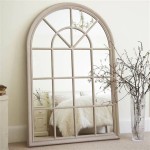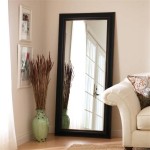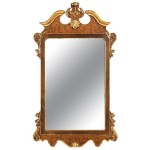Hanging A Large Mirror On Drywall: A Comprehensive Guide
Hanging a large mirror can significantly enhance the aesthetics of a room, adding depth, light, and a focal point. However, installing a heavy mirror on drywall requires careful planning and execution to ensure it remains securely in place and doesn't damage the wall. This article provides a detailed guide outlining the necessary steps and considerations for successfully hanging a large mirror on drywall.
Understanding Drywall and Weight Limits
Before attempting to hang a mirror, it is crucial to understand the limitations of drywall. Drywall, also known as gypsum board, is a relatively weak material consisting of a gypsum core sandwiched between two layers of paper. Its primary function is to provide a smooth surface for painting or wallpapering. Drywall alone cannot support significant weight, especially the weight of a large mirror. While some sources may suggest minimal weight limits for drywall, relying solely on the drywall itself is generally not recommended for mirrors exceeding a few pounds.
The weight-bearing capacity of drywall is significantly increased when using appropriate anchors. Anchors distribute the weight over a larger surface area, transferring the load from the hanging point to the surrounding drywall or, ideally, to a structural stud behind the drywall. The type of anchor required depends on the weight of the mirror and the presence (or absence) of studs in the desired location.
It is essential to accurately determine the weight of the mirror before proceeding. This information is typically found on the mirror's packaging or can be obtained by weighing the mirror using a bathroom scale. Knowing the precise weight is crucial for selecting the appropriate type and number of anchors.
Locating Studs and Choosing Appropriate Anchors
Ideally, the best and most secure method for hanging a heavy mirror is to attach it directly to a wall stud. Studs are vertical wooden or metal beams that form the structural framework of the wall. Attaching the mirror to studs provides a solid and reliable support system. Studs are typically spaced 16 or 24 inches apart, center to center.
There are several methods for locating studs. A stud finder is an electronic device that detects changes in density behind the drywall, indicating the presence of a stud. Magnetic stud finders detect nails or screws used to attach the drywall to the studs. Alternatively, tapping lightly on the wall can help locate studs; a solid sound indicates a stud, while a hollow sound suggests empty space. Once a stud is located, it is advisable to use a small nail or screw to confirm its precise location. Drive the nail or screw through the wall at the perceived stud location. If it hits solid wood, it's likely a stud. If it goes in easily and feels empty, try another spot slightly to the left or right.
If one or more studs are conveniently located behind the desired hanging position, use wood screws long enough to penetrate the stud by at least 1.5 inches. This ensures a secure grip. The diameter of the screw should be appropriate for the mirror’s hanging hardware and the weight of the mirror. For heavier mirrors, consider using lag screws with washers for added support. Pre-drilling pilot holes in the studs before inserting the screws is recommended to prevent the wood from splitting.
When studs are not available in the desired location, drywall anchors become necessary. There are various types of drywall anchors, each with different weight capacities and installation requirements. Choosing the right anchor is critical for ensuring the mirror remains securely in place. Some common types of drywall anchors include:
- Self-Drilling Drywall Anchors (Screw-In Anchors): These anchors are easy to install and suitable for lighter mirrors (typically up to 20-30 pounds). They are screwed directly into the drywall without pre-drilling.
- Molly Bolts: Molly bolts provide a stronger hold than self-drilling anchors and are suitable for medium-weight mirrors (typically up to 50 pounds). They are inserted into a pre-drilled hole, and as the screw is tightened, wings expand behind the drywall, creating a secure grip.
- Toggle Bolts: Toggle bolts are among the strongest drywall anchors and are suitable for heavier mirrors (typically up to 100 pounds or more). They consist of a bolt and a spring-loaded wing that expands behind the drywall when inserted. Toggle bolts require a larger pre-drilled hole to accommodate the wings.
- Heavy-Duty Drywall Anchors (Snap Skru, Toggler Alligator): These anchors are designed for medium to heavy loads and offer excellent holding power in drywall. They often feature a ratcheting or expanding mechanism that securely grips the back of the drywall.
It is crucial to carefully read and follow the manufacturer's instructions for each type of anchor. Using the wrong anchor or installing it incorrectly can lead to the mirror falling and causing damage or injury. Always check the weight rating of the anchor and ensure it is adequate for the weight of the mirror.
Installation Steps: A Step-by-Step Guide
Once the studs have been located (or the decision to use drywall anchors has been made) and the appropriate anchors have been selected, the installation process can begin. Here is a step-by-step guide for hanging a large mirror on drywall:
- Gather Materials: Collect all the necessary materials, including the mirror, stud finder (if applicable), drywall anchors (if applicable), screws (if attaching to studs), level, measuring tape, pencil, drill (if required for the chosen anchor), screwdriver, and safety glasses.
- Mark the Hanging Location: Use a measuring tape and pencil to mark the desired location for the top of the mirror on the wall. Ensure the mark is level using a level.
- Locate Studs (If Applicable): Use a stud finder or other method to locate studs near the marked hanging location. Mark the center of the stud(s) with a pencil.
- Install Anchors or Screws:
- If Attaching to Studs: Pre-drill pilot holes through the drywall and into the stud at the marked stud locations. Use screws long enough to penetrate the stud by at least 1.5 inches to securely attach the mirror hanging hardware.
- If Using Drywall Anchors: Follow the manufacturer's instructions for installing the chosen type of drywall anchor. This typically involves drilling a hole (if required), inserting the anchor, and tightening the screw or bolt. Ensure the anchors are securely fastened to the drywall.
- Attach Hanging Hardware: Attach the appropriate hanging hardware to the mirror, ensuring it is securely fastened. This may involve using screws, D-rings, or wire.
- Hang the Mirror: Carefully lift the mirror and align the hanging hardware with the installed screws or anchors. Gently hang the mirror on the screws or anchors.
- Check for Level: Use a level to ensure the mirror is perfectly level. Adjust as needed until the mirror is level.
- Secure the Mirror (Optional): For added security, especially with heavier mirrors, consider using adhesive pads or bumpers on the back of the mirror to prevent it from shifting or scratching the wall.
Safety is paramount when handling large mirrors. Always wear safety glasses to protect your eyes from debris. If the mirror is particularly heavy or unwieldy, enlist the help of another person to lift and hang it. Ensure the area around the hanging location is clear of obstacles.
After hanging the mirror, periodically check the anchors or screws to ensure they remain tight and secure. If any signs of loosening are observed, tighten the screws or replace the anchors as needed. Regular maintenance will help prevent the mirror from falling and causing damage.
How To Hang A 100 Pound Mirror On Drywall Quora

How To Hang A Large Or Heavy Mirror

How To Hang A Heavy Mirror On Drywall Stas Picture Hanging Systems

How To Hang A Heavy Mirror Ask This Old House

A Better Way To Hang Heavy Mirror Hanging Brackets

How To Hang A Heavy Mirror
:strip_icc()/ScreenShot2022-04-28at1.12.19PM-e055476c70c6438585fa7c5cd531edcf.png?strip=all)
4 Easy Ways To Hang A Heavy Mirror

How To Hang A Heavy Mirror With French Cleat

How To Hang A Heavy Mirror Diy Family Handyman

How To Hang A Heavy Mirror







